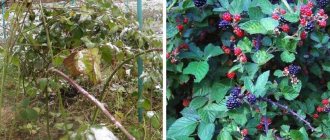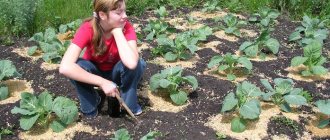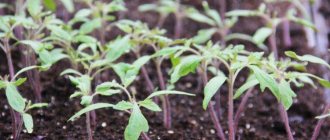Selection of planting material
Seedlings are selected from standard varietal plants. You will learn about the best gooseberry varieties for growing in this article.
In order for young gooseberries to take root, the following requirements are taken into account:
- the root system must have at least 3 skeletal roots 20-25 cm long;
- the above-ground part should contain 2-3 strong branches measuring about 30 cm;
- seedlings are selected without mechanical damage.
Plants with an open root system are taken without leaves (except for the top), and bushes with a closed root system, on the contrary, are taken leafy.
Preparing the planting hole
For the future growth of the shrub, it is important to properly lay and fertilize the planting hole. Dig a hole measuring 50x50 cm. The depth is 2/3 of the root system. The optimal distance between bushes is 1.5 meters, and between rows 2.5 m. Thanks to the large distance, the risk of powdery mildew is significantly reduced and the feeding area is increased.
The soil from the dug hole is mixed with compost or rotted manure (1 kilogram per hole). Add 1 cup of wood ash. These substances enrich the soil with nitrogen, potassium and phosphorus. Fill the hole 2/3 full with fertile soil. Leave for a week for the soil to settle.
Autumn planting
Autumn is a favorable time for planting. Over the winter the shrub will take root well and take root.
Optimal timing
Gooseberries are planted in late September - mid-October (depending on the climate). The event is held a month before the first sub-zero temperatures. The roots begin to go deeper into the soil at daytime temperatures of + 10...+15 C. In case of premature frosts, planting is postponed until spring, since the plant will not have time to take root and will freeze out.
Soil preparation
The shrub loves fertile, loose soil in well-lit, ventilated areas, but does not tolerate waterlogging. Therefore, it is not planted in wetlands and close to groundwater.
Gooseberry bushes prefer neutral or slightly acidic soil. If the soil is acidic, add limestone or dolomite flour. Before planting, the area is dug up and cleared of weeds.
You can determine the increased acidity of the soil as follows: if moss, sorrel, and horsetail grow on the site, the acidity is high.
In order for the soil to settle, holes are dug 2-3 weeks before planting. The optimal depth is 50-55 cm, width is 55-60 cm. The holes are filled 2/3 with fertilizers (superphosphate, ash, rotted manure).
Step-by-step recommendations for planting
Autumn planting of gooseberries is carried out in several steps:
- Inspect the bush for damage, remove unhealthy parts and broken roots with pruning shears.
- The plant is placed to a depth of no more than 5 cm at the root collar.
- Sprinkle the roots with soil so that there are no voids between them.
- Compact the soil with your feet (not too much) to secure the bush to the soil surface.
- The tree trunk circle is watered with 5 liters of water.
- Mulch the soil with peat or humus.
The seedlings are watered once every 4-5 days (if there is no rain).
10 days after planting, gardeners recommend treating the bushes against pests and fungi for prevention. In autumn, seedlings are not pruned.
In this video, the gardener shares his experience of planting gooseberries in the autumn:
Do I need to insulate for winter?
Gooseberries are a frost-resistant crop. Adult plants are not specially covered for the winter; snow cover is sufficient to retain heat. Seedlings, especially in regions where winters are cold, protect against freezing. Plants are covered with spruce branches, fallen leaves or agrofibre.
Basic rules and instructions on how to plant gooseberries in the spring:
Soil preparation
After which it is better to plant zucchini in the spring
The stage depends on the initial condition of the soil. The main objectives are:
- Leveling the acidity of the soil using dolomite flour (the proportion is selected according to the instructions on the package) or ash;
- Bringing the soil into proper condition. You need to dig up the planting site, remove all weeds, roots, stones and other debris. On heavy soils you need to add sand; on the contrary, too light soils need to be balanced with clay soil;
- Application of a complex of fertilizers - humus, compost, rotted manure in a ratio of 1:3, as well as potassium and phosphorus fertilizers (consumption according to the instructions on the package).
Planting depth
The size of the planting hole depends on the size of the seedling. Usually they dig a hole from 40 to 60 cm in diameter and 50-60 cm deep. If the plant is very small, then the hole should be made smaller.
Distance between seedlings
Gooseberries really love space, so that air exchange occurs normally, and the plant itself receives a sufficient amount of nutrition through the roots. Therefore, there is no need to install a stockade. The distance between bushes should be at least 150 cm. When growing a large number of bushes in rows, you need to leave a row spacing within 250 cm. Such distances are optimal for ensuring favorable conditions for growing and picking berries.
Correct conditions
Preparation of seedlings
Before planting, the plant must be hardened off without removing it from the container. A seedling with closed roots is buried in the ground, watered and left on the site for 7-10 days. Then the cuttings are dug up, after moistening the soil, the material is carefully removed from the container and inspected for diseases and damage. All wounded parts or damaged roots must be removed with a sharp, disinfected knife. After this, preventive treatment with potassium permanganate should be done. To do this, you need to soak the roots in a 1% solution for 5 minutes. To maintain growth, you can soak the roots in an activator (for example, Kornevin), observing the period and dosage specified in the instructions.
Planting methods
- Standard . The optimal planting option that does not require thinning or replanting. Bushes are planted in rows with a gap of 1.5 m and a row spacing of 2 m;
- Compacted . The distances with this method are 2 times less than standard. After 3-4 seasons, the bushes will grow so that their branches begin to intertwine. This is a sure sign that it is time to plant them. The dug up bushes can be moved to another place or put up for sale, or thrown away if they are weak. After a couple of seasons, thinning is done again;
- Economical . If the area is not intended exclusively for gooseberries, then the bushes are planted based on the availability of free space. The best place for this is the area near the house or under the trees that are already growing in the garden. With this method, the main thing is to maintain a free zone of 1.5 m around the bush.
Spring planting
In spring, gooseberries are planted before sap flow begins. If you neglect the deadlines, you may not wait for a bountiful harvest, the bush will grow weak.
Optimal timing
The favorable time for planting in spring depends on the region. In warm regions, gooseberries are planted in March, in the northern regions - until the end of April. Plant until the buds swell.
Soil preparation
It is better to fertilize the soil in the fall. In spring, it is difficult to apply fertilizers due to high soil moisture. The choice of planting site and soil acidity are no different from planting in the fall.
Gooseberries are not planted where raspberries, other varieties of gooseberries, and currants used to grow, since these plants are affected by common diseases and pests. Places where peas, potatoes, and beets grew are considered favorable for planting.
Step-by-step recommendations for planting
Spring planting of seedlings consists of the following steps:
- Seedlings are inspected for damage. Sick, dry, rotten roots are removed.
- The bushes are treated with a biostimulant solution (Zircon, Epin). This way the root system will take root better.
- In order for the root shoots to grow faster and take root, the plant is placed in the hole at an angle of 45 degrees.
- The soil around the seedling is compacted (not tightly) and watered with water.
- Aboveground shoots are cut to 15-20 cm, leaving 3-4 buds.
After planting, the bushes are watered once a week (until the roots are established). The tree trunk circle is regularly weeded. To protect against weeds, the soil is mulched with peat and leaves.
Watch the following video on how to plant gooseberries in spring:
The consequences of choosing the wrong place
A healthy, actively growing bush is the result that a gardener will receive if he follows the planting rules. If growth is slow and there are few berries, it means that not enough attention was paid to the question of where to plant gooseberries:
- If the area is swampy, does not dry out, water stagnates there, and fungus will begin to develop on the bush.
- An area exposed to the wind will lead to weakness and slow development of the bush.
- Partial shade is acceptable conditions for the plant, but the harvest will come later. It is recommended to plant one of several bushes in partial shade, so that after harvesting the main harvest you can get another one. Dense shadow will lead to disease and death of the bush.
- Gooseberries on the site should not be in the form of 1 bush, so you need to immediately plan to plant several specimens.
- When planting on a southern slope, even with a slight slope, there is a risk of permanent sunburn of the plant.
- In the absence of buildings or trees capable of holding snow, the gooseberry may freeze or lose fruit buds.
We recommend that you read Storing barberry
Various ways to grow gooseberries
In addition to the usual bush formation, gooseberries are grown on a trunk and on a trellis. Let's consider these agricultural methods.
On the trellis
Growing berry bushes on a trellis has its advantages:
- evenly spaced branches of the bush increase illumination, which contributes to the smooth ripening of berries;
- vertical planting has a positive effect on the quality of the crop: the fruits grow large and sweet;
- bushes become less dirty and become infected with fungal infections.
Trellis - reinforced concrete, wooden, plastic pillars (pipes) about 2 m in size are placed on both sides of the row. Wire is stretched between the pillars at 3 levels. Several bushes (5-6) are planted at a distance of 0.5 to 1 m from each other, the branches are arranged in the shape of a fan. The plant is then tied to the bottom wire of the structure and directed vertically. Seedlings are pruned to 3-4 buds.
The shoots that have grown from the root collar are removed in the second year to form the shoot wall thickness and density. The lateral growths grown on the main bushes are shortened above the 5th leaf.
They care for the shrub as with normal planting: mulch, water, and trim. Fertilizers are applied in the spring.
Gooseberry without thorns
Breeders have developed thornless gooseberry varieties, which are in great demand among gardeners. These varieties are distinguished by early and rich fruiting. A good harvest is harvested in the second year after planting, and an adult shrub produces up to 1.5 kg of fruit.
The thornless gooseberry loves fertile soils. In the fall they fertilize with organic compounds, and in the spring with ammonium nitrate or urea.
The peculiarity of these varieties is that the bushes do not pollinate well, so they are planted at a distance of at least a meter from each other. Otherwise, planting and pruning plants is no different from other varieties.
Growing standard gooseberries
Gooseberry bushes arranged in a standard way not only serve as decoration for the garden, but also have their own advantages:
- the plant receives more light, due to which the berries ripen evenly and grow large and sweet;
- It is more convenient to harvest and care for shrubs in the form of a tree;
- In small areas, standard planting saves space.
Shrubs are grown using the standard method, both with and without grafting. A scion of golden currant is taken as a rootstock and cared for throughout the summer. To thicken the trunk, the apical shoots are removed. When the trunk is prepared, ripened gooseberry shoots are selected, thorns and leaves are removed. Then the shoot is shortened above the third bud and grafted using the “bark” method.
When grown without grafting, the above-ground branches of a strong gooseberry bush are cut off, leaving only one shoot to form the trunk. Side branches are periodically removed to a height of 70-80 cm from the ground. Leave 5-6 top shoots to form a crown.
The best gooseberry varieties for growing using the standard method:
- "Krasnoslavyansky";
- "Generous";
- "Spring";
- "Redball"
- "Kolobok";
- "Sadko" and others.
Caring for gooseberries is the same as when planting in the usual way. In cold regions, standard shrubs are recommended to be insulated for the winter, for example, with frame shelters.
Features of cultivation in different regions
Climatic conditions are taken into account when growing fruit and berry crops. For each region, breeders have developed zoned gooseberry varieties:
- Residents of the northern regions should pay attention to frost-resistant varieties (“Northern Captain”, “Yarkiy”, “Severyanin”, “Grushenka”, “White Nights”, “Finnish”, etc.). In the northern regions, large-fruited and late-season species are planted in a warmer place, protected from the winds. Protection can be fences, trees, buildings.
- For central Russia , the Moscow region, and the North-West, it is recommended to grow winter-hardy varieties, varieties with a strong root system and resistance to diseases (“Grushenka”, “Malachite”, “Kazachok”, “Lefora”, “Senator”, “Seyanets”, “Harlequin” " and etc.).
- In the South, it is better to plant drought-resistant, mid-season, early varieties (“Kubanets”, “Grossular”, “Krasnoslavyansky”, “Kuibyshevsky”). For early and small-fruited varieties of the southern regions, cool, open places are suitable.
The best gooseberry varieties for the northern regions
Thanks to the efforts of an army of breeders, many high-yielding gooseberry varieties with good winter hardiness have been developed today. Plants tolerate frosty winters without problems. Popular varieties for the Urals and Siberia:
Ural grapes are an early variety of gooseberries. Has high winter hardiness. The bush is vigorous, semi-spreading, with straight shoots. Berries weighing up to 8 g, oval in shape, emerald green in color. Without pubescence and thin skin. The pulp is juicy and has a dessert taste.
Ural emerald is a medium-early ripening gooseberry. At the moment of ripening, the berries acquire an emerald color and a round-oval shape. Externally, the berries are without pubescence. Very tasty. Productivity from one bush is up to 5.6 kg. Winter-hardy.
Gooseberry Ural emerald. Photo
Ballet is a medium-ripening gooseberry. The bush is low, with a small number of thorns - thorns appear only on the upper part of the shoot. The berries are round in shape, red in color, weighing up to 5 grams. The taste is sweet and sour. The plant tolerates cold temperatures down to -41.8 degrees.
Belarusian sugar is a mid-season gooseberry variety with green berries. Average weight up to 5 grams. Rare specimens up to 8.5 g. Sometimes, at the moment of ripening, the berries acquire a light brown tint. The bush is tall with erect thick shoots. The spikiness is average. It has high winter hardiness, up to -39 degrees.
Severyanin is a late-ripening variety. The bush is medium-sized, slightly spreading. The thorns are located along the length of the entire shoot. The berries are green or yellow, round-oval in shape. The skin is dense but thin. Thanks to this, the berries are well stored fresh. The bush has high winter hardiness and resistance to powdery mildew.
Caring for gooseberries in different seasons
In the spring , after the snow melts, the rows and row spacing are loosened, since the soil at this time is highly compacted. In order not to touch the roots, the soil in the tree trunk circles is loosened no deeper than 5 cm. Spring is the time for fertilizing, treating bushes from pests, sanitary and formative pruning.
In summer, the soil is loosened as needed, usually 3-4 times per season. At the beginning of August, they stop loosening the rows and rows so as not to provoke the growth of young shoots.
For growth, protection from weeds, and preservation of moisture in summer, tree trunk circles are mulched. In autumn, the procedure is carried out after digging the soil.
Autumn is the time to prepare gooseberries for winter and the time of pruning.
We recommend reading the article on how to care for gooseberries after harvest.
Regularity of watering
Without moisture, shrubs often become sick, the berries become smaller, and the yield decreases. In dry weather, gooseberries are watered during the formation of young shoots and ovaries. The bushes are also watered during the ripening period of the berries. As soon as the fruits become softer, stop watering so that they gain sugar.
If autumn is rainy, gooseberries are not watered. If there is little rain, water-charging irrigation is carried out in October to prepare the root system for winter.
When and what to feed?
In the spring, gooseberries are fed with manure or humus, placed on the earth dug up around the bush. During bud break, 40-50 g of ammonium nitrate or urea are added to each bush. 4 years after planting, every spring they are fertilized with nitrogen, phosphorus, and potassium compounds.
When the berries begin to set, water them with slurry or a solution of mineral fertilizers (1-1.5 kg of ammonium sulfate or nitrate are placed on a hundred-liter barrel of water).
You can prepare the following composition: 4 kg of manure and 200 g of ash are diluted in 10 liters of water and left for 5-6 hours. In the evening, the bushes are watered with this solution after loosening. After 1-2 weeks, fertilizing is repeated. Before the berries ripen, the bushes are fertilized 2-3 times.
In autumn, the plant is fed with potassium nitrate or double superphosphate. Before digging the soil, add manure, ash, peat or compost.
Pruning: rules and methods
For proper development and good fruiting, gooseberry bushes are regularly pruned. Depending on the goals, formative, rejuvenating, and sanitary pruning is carried out.
Formative pruning serves to create the correct crown and has its own subtleties:
- in the first year of planting, the branches are cut by half, in the second - by a third, in the third - the tops and horizontal branches are cut off;
- an adult bush is cleared of non-viable and twisted branches and young shoots are pruned from overgrowth.
The bush takes up to 8 years to form. By this time, the bush should have 22-25 strong shoots.
Anti-aging pruning is carried out after 7 years of planting as follows:
- old, diseased, twisted shoots are cut off, leaving only strong basal stems;
- for a plant older than 10 years, only 5 strong branches are left, the remaining branches are removed from the base.
Sanitary pruning is used to prevent thickening and to prevent infection by diseases and pests. Remove old, diseased, blackened branches and horizontal growth.
In the following video, the gardener talks in detail about the correct pruning of gooseberries:
In the spring, sanitary pruning is carried out before the buds open. Places of large cuts are treated with garden varnish. In the fall, formative, sanitary, and rejuvenating pruning is carried out. The best period is November, after the leaves fall.
Disease Control
Diseases have a detrimental effect on the harvest and the plant itself. Let's look at the main diseases of gooseberries and ways to combat them.
Anthracnose is a fungal disease that affects gooseberries, currants, raspberries and other crops. The infection spreads in damp, dense and poorly ventilated places. Symptoms of the disease:
- the appearance of brown spots on leaf blades;
- leaf falling.
Affected plants are sprayed with Bordeaux mixture (300 g of copper sulfate and 400 g of lime are taken per 10 liters of water) until flowering. After flowering and harvesting, the concentration of the solution is reduced (take 100 g of copper sulfate and 100 g of lime per 10 liters of water).
In autumn, fallen leaves of diseased plants are burned. If you do not remove the infected leaves, the bush will become sick again in the spring.
Septoria disease develops in warm weather. Pathogens are fungal spores. Symptoms of the disease:
- brownish spots appear on the leaves, which turn white over time, and a brown border appears on the edges;
- leaf falling.
The contaminated soil is treated with copper sulfate, Bordeaux mixture or nitrafen. Spray the plant until the buds open.
Spherotheca (American powdery mildew) is a dangerous fungal disease.
Symptoms:
- the leaves become covered with a white coating in spring;
- shoots become bent and dry out.
It is difficult to get rid of this disease, since the fungus overwinters not only on the leaves, but also on the shoots. In the spring, for preventive purposes, the tops of the bushes are watered with hot water.
Control methods are the same as for anthracnose and septoria.
Mosaic is a viral disease. The disease is spread by insects. Symptoms of the disease:
- a yellow pattern appears on the veins of the leaves;
- shoots stop growing;
- the leaves become smaller and wrinkled.
Mosaic is difficult to treat, so it is better to get rid of diseased bushes. For preventive purposes, shrubs are sprayed with insecticides.
Pest Control
In addition to dangerous viruses and fungal diseases, berry crops are threatened by pests.
The currant beetle is a wasp-like butterfly with transparent wings. The insect lays eggs on branches. After 10 days, caterpillars emerge from the eggs and penetrate into the core of the branches, disrupting the physiological processes of the plant.
Control measures:
- In the fall, sanitary pruning is carried out followed by the destruction of the affected branches;
- In spring, gooseberries are treated with Iskra M, Kemifos, and Fufanon.
To repel glass flies, folk remedies are used: infusions of onion, wormwood, tansy, and garlic.
The moth is a gray-winged butterfly that lays eggs inside the inflorescences and on the ovaries. Caterpillars eat flowers and berries. In mid-June they turn into pupae in the ground and overwinter.
Control measures:
- when the caterpillars appear, the plant is sprayed with lepidocide (5-6 tablets per 1 liter of water), after a week the procedure is repeated;
- a fufanon solution (110 ml per 10 liters of water) will destroy not only the moth, but also moths and sawflies.
Shoot aphids parasitize the tips of shoots, sucking juices from the leaves. Aphid eggs remain on the bark until spring. After the buds open, larvae emerge from the eggs.
Control measures:
- in early spring, the bushes are watered with hot water;
- treated with a three-day infusion of onion feathers or onion peels;
- spray with infusion of wood ash (350 g per 10 liters of water);
- in case of severe damage, before the buds open, the drugs “Aktara”, “Rovikurt”, “Fovatox”, etc. are used.
Regular inspections and preventive spraying with insecticides will protect shrubs from damage and death.
The gooseberry sawfly is a fly-like insect that is yellow or black and red in color. Lays eggs on leaves.
Control measures:
- Infected foliage is burned in the fall;
- in early spring, the ground is loosened, a mixture of ground pepper (1 tbsp), dry mustard (1 tbsp), ash (2 tbsp) is added and covered with film to destroy the pest;
- larvae (caterpillars) are collected by hand and destroyed;
- insecticides are treated during bud opening and after flowering.
Regular inspection and preventive treatment with insecticides will protect the plant from damage and death.
How to increase fruiting
Many farmers who grow gooseberries are thinking about how to increase the fruiting of the bush. Several simple but effective ways will help you make your wish come true. First you need to start thinning the crown of the bush.
The more sunlight penetrates inside, the more berries will form on the branches.
The second rule is to apply timely and high-quality fertilizing. During the entire growing season, it is necessary to fertilize shrubs 5 times:
- at the stage of leaf blossoming (200 g of nitrophoska per 10 liters of water). 15 liters of solution are poured under each bush;
- during the flowering period (100 g of potassium sulfate per bucket of water). There are 5 liters per bush;
- when fruit ovaries are formed (200 g of potassium humate per 5 liters of water). Each bush is watered with 3 liters of solution;
- at the end of September (200 g of superphosphate per 20 liters of water). The prepared volume is poured under 1 bush;
- at the end of October (5 kg of humus is poured under each bush).
How to propagate gooseberries?
Propagation by cuttings and layering is not difficult for amateur gardeners, but there are methods that require special knowledge or expert advice. Let's look at the most popular methods of reproduction.
by horizontal layering in March – April (before buds open) and in October. Reproduction is carried out in several stages:
- From a healthy 5-6 year old bush, take developed branches (from 1 to 3 years old) growing near the ground.
- Annual shoots from the branches are cut by a third.
- The branches are bent to the ground and placed in the holes.
- The holes are lightly sprinkled with earth, watered, and mulched.
- After the shoots grow to 10 cm, they spud. When shoots grow above 20 cm, pinch off the tops.
Horizontal propagation produces many young shoots. In spring, the shoots become annual seedlings.
by arcuate layering in early spring. The stages of reproduction are as follows:
- Annual shoots located low to the ground are placed in grooves up to 25 cm deep.
- The cuttings are pinned and covered with earth.
- The tops are brought out in the shape of an arc, shortened and hilled.
In the fall, the shoot is separated from the mother bush and planted. With the arcuate method, you can get only one shoot.
Vertical layering rejuvenates plantings. In spring, old branches are removed and young ones are pruned. In the summer, as the shoots grow, the gooseberries are hilled. To form a bush in June, the tops are pinched.
By dividing the bush, it is propagated in the fall after the leaves fall or in early spring. The method is usually used if you want to move a shrub to a new place. Young bushes are dug up and divided into parts. Branches with a developed root system are planted in pre-prepared holes.
by cuttings in autumn, spring, summer. Depending on the seasons, cutting technology varies. In summer, gooseberries are propagated by green cuttings, in autumn and spring - by woody or combined cuttings.
Requirements for propagation by cuttings:
- the cutting must contain at least two buds and two leaves above them;
- the cut on the upper section should be straight, horizontal, and on the lower section – oblique;
- After cutting, the cuttings are kept in a growth stimulator for several hours.
In addition to the above methods, gooseberries are propagated by seeds, shoots, and branches. The choice of method depends not only on the personal preferences of the gardener, but also on the characteristics of the variety.
Collection and proper storage
Gooseberries for processing are harvested two weeks before consumer ripeness, when the berries are still green and firm, but have reached their size.
For fresh consumption, the berries are harvested when fully ripe, sweet in taste and with a color characteristic of the variety.
Harvest collected at the stage of technical ripeness (10-14 days before consumer ripeness) is stored in a cool place for up to 10 days. An important condition is that the fruits must be without damage. Berries collected at the stage of consumer ripeness are stored in small baskets for up to 4-5 days.
The fruits are removed from the bush in dry weather. In humid weather, gooseberries do not last long. Before storing, the berries are scattered in a thin layer to dry.
Common gardening mistakes
If the gooseberry is often sick, produces little yield, and looks frail, it means that mistakes were made during planting and care. Common gardening mistakes:
- Wrong place. Planting in shaded, poorly ventilated, waterlogged places leads to poor development of the shrub and damage by diseases and pests.
- Mistakes when watering. Completely moistening the bush provokes fungal infection. Only the tree trunk circle is watered.
- Root damage. The roots are located close to the soil surface. Deep digging and loosening can damage their integrity.
- Neglect of fertilizing and preventive treatment. If you do not fertilize the plant, the quality and quantity of berries will suffer.
Not to say that gooseberries are a capricious crop, but it is necessary to follow agrotechnical cultivation measures. With proper care, the plant can be grown in any climatic conditions; fortunately, there are now plenty of varieties.
0
0
Copy link
Mistakes when planting gooseberries in spring
- Delayed landing . When planting in spring, every day counts. Gooseberries emerge from hibernation very early. If you miss the moment and plant the plant when buds have begun to form, then there is a very high probability that the bush will not take root;
- Strong root penetration . It is very important to know: if you cover the trunk excessively with soil (the roots are sunk into the ground deeper than 7 cm), then the development of the plant will be very inhibited and the branches will be frail. This will lead to the development of diseases and low fertility;
- Neglect of inspection and pre-planting treatment of roots . A known diseased plant will definitely not take root and will die;
- Too frequent, but at the same time economical watering ;
- Lack of formative and sanitary trimmings .
Planting roses in spring: when and how to plant roses











